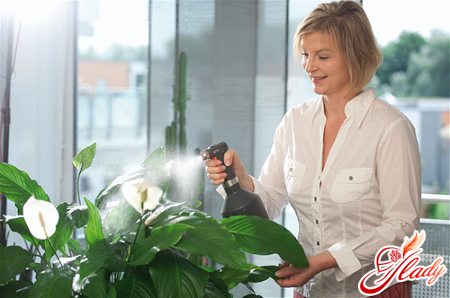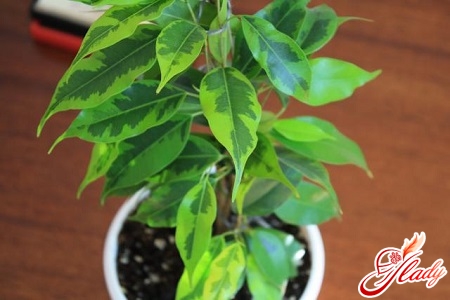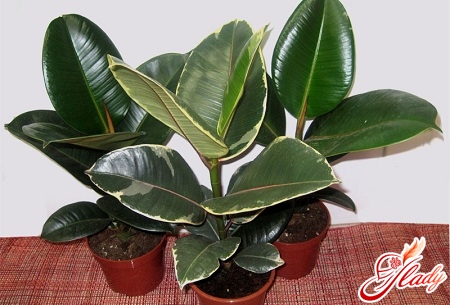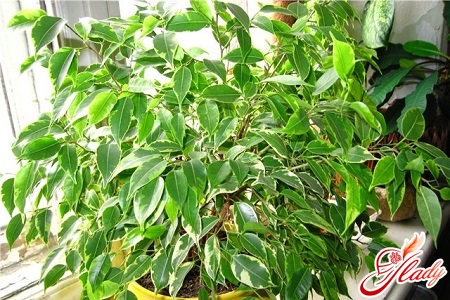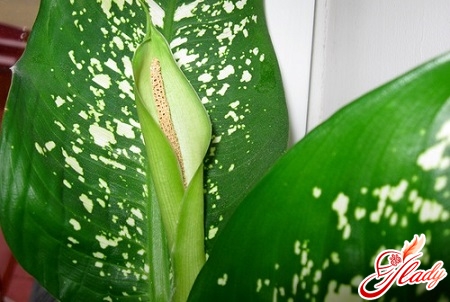 A house with indoor plants is beautiful.initially. The air in it feels fresher, the light is brighter, and the walls are cleaner. Green islands are pleasing to the eye and can become a good hobby for their owners. However, as in any other areas of life, you will inevitably encounter the problem of flower diseases. All living organisms are susceptible to pathogenic microbes, including plants. We offer you a short guide to houseplant diseases - it will help you correctly diagnose the problem and get rid of it in the shortest possible time.
A house with indoor plants is beautiful.initially. The air in it feels fresher, the light is brighter, and the walls are cleaner. Green islands are pleasing to the eye and can become a good hobby for their owners. However, as in any other areas of life, you will inevitably encounter the problem of flower diseases. All living organisms are susceptible to pathogenic microbes, including plants. We offer you a short guide to houseplant diseases - it will help you correctly diagnose the problem and get rid of it in the shortest possible time.
Diseases of flowers caused by viruses
Viral diseases in indoor plantsare quite difficult to diagnose. When they develop, the growth of the flower slows down, so the diagnosis often comes down to unfavorable conditions and insufficient nutrition. In addition, viruses are difficult to detect because the plant rarely dies, and the symptoms are often confusing. How to understand all these flower diseases?
The parts of the plant affected by the virus should beremove and destroy. After that, wash your hands thoroughly with soap. It is impossible to fight viruses using chemicals. And the exact type of disease is very difficult to determine. That is why it is much more correct to prevent the appearance of the virus. To do this, regularly fight insects that usually carry pathogens. Use only cuttings from healthy plants, since quite often the flower becomes infected in the greenhouse through mechanical damage to the stem or root. In hot and dry weather, the plant must be brought into the shade and sprayed more often.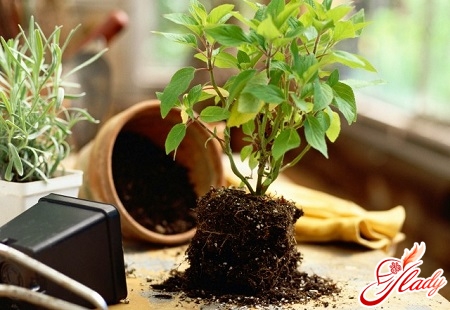
Diseases of flowers caused by fungi
A fairly common disease of flowersis powdery mildew. It is caused by the fungus sphaerotheca pannosa. The first evidence of its presence is the appearance of small whitish spots. You can easily wipe them off with your finger, but they will definitely return, having increased in size and acquired a grayish tint. Over time, the mycelium will become increasingly dense, which will eventually lead to the appearance of a brown powdery coating. It can be present on both sides of the plant leaves. Which, by the way, will gradually dry out, wither and fall off. The growth of the flower will eventually stop. High humidity and warm room temperatures of about eighteen to twenty degrees are most favorable for the development of this fungus. If you catch the disease at an early stage of its development, then the affected leaves or buds must be removed. If the fungus continues to spread, choose special products to combat powdery mildew: "skor", "vektra", "topaz". But you can, using preventive measures, protect your plant from this misfortune. To do this, pollinate with sulfur three or four times during the summer. Do not forget to thoroughly ventilate the room, but without a cold draft. Monitor the amount of fertilizer used. In particular, overfeeding flowers (especially during budding) with nitrogen fertilizers is fraught with the development of powdery mildew. Peronosporosis is similar to the disease of indoor plants described above - it is also called false powdery mildew. First of all, this fungus affects the leaves, but it also does not disdain flowers and stems under favorable conditions. At the very beginning, grayish-yellow spots appear on the upper part of the leaves. They have a blurred outline and are quite pale. Below, on the affected areas, you can see a light gray coating, which is nothing more than the mycelium of the fungus. As the disease progresses, it darkens, and the leaves become corrugated, sluggish and gradually dry out. To get rid of this disease, carefully remove diseased leaves and heavily affected plants. It is recommended to spray the remaining areas with a one percent solution of Bordeaux mixture, you can also use a solution of soda ash in a concentration of 0.5 percent. Pay special attention to the underside of the leaves. Special means against this disease are "kuproksat" and "oksihom". You will need to take a course of at least five antifungal treatments, the duration of each should be from seven to ten days. Of course, it is better to prevent the disease than to treat it. To do this, maintain low humidity, regularly ventilate the room with flowers, thin out and clean the plants, change the soil and disinfect it. There is a whole group of diseases of indoor plants caused by both fungi and bacteria. They are called "spots". They appear as brown dry or wet spots. As the disease develops, these neoplasms grow, merge and capture the entire area of the leaf. At the initial stage, spotting is not too dangerous, but if the disease spreads to the stem, the risk of plant death increases. What types of this disease are the most common?
- Anthracnose Most often, it affectsficus and palms. In a diseased plant, you can see brown areas on the leaves with dark brown streaks on the tips. It is possible that small reddish or brown spots with a gray or yellow border will appear, gradually increasing in size. They are usually located in the middle (unlike the situation with overdrying of the soil, when they shift closer to the edge of the leaf).
- Septoria is characterized by the appearance ofdark gray or dark brown spots with a yellow border (such symptoms can be seen in anthurium), or small reddish or reddish-yellow dots (more common on azaleas), which gradually grow. As the disease progresses, blackening appears in the center of the spots. You should be especially careful with them, since these are the fruiting organs of the fungus. They can remain on the leaves throughout the winter even at subzero temperatures and continue to spread in the spring.
- Red burn Affects hippeastrums.When a flower is affected by this disease, narrow red spots form on the peduncles, bulbs and leaves. Subsequently, spore-bearing crusts appear on them. Deformation of flowers and leaves begins, which leads to the cessation of flowering and rotting of the bulbs.
- Phyllostictosis Characterized by dark ovalor round spots with a rather dark border on the border with the healthy part of the leaf. Often the damaged tissue falls out, and you can see how the leaf gradually becomes perforated.
- Ascochytosis Small spots appear firstof various shapes. They can be brown or reddish with a brown or yellow rim. This disease can occur in indoor plants in varying degrees of severity. The most unpleasant is ascochytosis of chrysanthemums, which most often affects plants belonging to the Asteraceae family.
All spottings are characterized by the sameTreatment regimen: remove and burn diseased leaves. After this, the entire plant should be treated with a systemic fungicide: Vectra, Strobi, Abiga-Peak, colloidal sulfur, Bordeaux mixture, copper sulfate - they are all suitable. The treatment course should be carried out twice with an interval of seven to ten days. You should also reduce watering and stop spraying so that moisture does not contribute to the spread of the fungus. In order to prevent spotting on your indoor plants, avoid warm and humid conditions. There should be no excessive watering or large crowding of flowers. Do not forget to regularly ventilate the room. Fusarium is another fairly common and dangerous disease for indoor plants. It affects flowers of any age. The fusarium fungus is found in the soil and penetrates it through it, as well as through wounds. In younger flowers, the first symptoms appear in the form of root rot: the tissues acquire a brown tint, the leaves turn yellow, and the stem becomes thinner. The tops begin to wither, which quickly spreads to the entire plant. Fusarium spreads in foci through the soil. Weakened flowers are most vulnerable to it. The form of the disease can be acute (the plant dies within five to seven days) or chronic (the disease lasts for weeks). Unfortunately, there are no effective ways to cure this disease at an advanced stage - it is better to eradicate the lesion by removing and destroying the flower along with the root system and clod of earth. The pots must be disinfected with a five percent solution of copper sulfate or bleach. But if the withering has just begun, you can try treating the plant with Benomyl or Vectra. An alternative way to save the flower is to cut off the upper cutting and transplant it into a new pot. Preventive measures for fusarium are the same as for other fungal infections: ventilation, loosening the top layer of soil, its disinfection. When working, use alcohol sterilization of tools: scissors, a knife and even garter material. There is a fungus with a rather interesting name "rust". It is formed from the type of spots that are a symptom of this disease - these are orange-brown tubercles. On the back of the leaf, you can see something like pimples of a round or oval shape. Over time, the spots turn into stripes, and the leaves of the plant begin to turn yellow and fall off. In order to prevent the development of this disease, it is necessary to water indoor flowers evenly, avoiding high humidity in the room. If you have already encountered "rust", then we recommend that you get rid of the affected branches and leaves. Spray the remaining parts of the plants with special agents: "strobi", "vektra", "topaz", cuproxate, Bordeaux mixture. The treatment must be repeated two or three times with a ten-day break.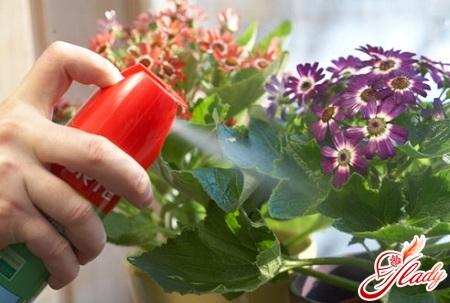
Diseases of flowers caused by bacteria
Just as in the world of people, in the world of indoorThere are many bacterial diseases that can harm your plants. They do not always have a clear clinical picture of development, and individual symptoms can be mixed with each other. All this significantly complicates diagnosis even for an experienced gardener. As you already understood, very often you can see spots on plants. Bacterial spotting is manifested by the fact that individual areas of the leaf die off, but, unlike diseases caused by a fungus, these spots do not have clearly defined boundaries - on the contrary, they are more likely to have blurry edges. These areas can be oily or glassy. They grow quickly, causing the leaf to dry out, turn yellow and die. It is logical that bacteria multiply faster in warm and humid conditions. Another bacterial scourge is rot. With it, plant tissues soften and die, after which a liquid rotten mass appears in this place, usually with an unpleasant odor. This disease is more common in houseplants with juicy fleshy stems and leaves, as well as those that have a lot of contact with damp soil - bulbous and tuberous. Rot can damage any part of the plant - leaves, roots, flower stalks. The development of infection is facilitated by poor maintenance conditions: excessive watering, cool temperatures, large amounts of nitrogen fertilizers. You can fight bacteria only if they have not penetrated the vascular system of the flower. The diseased plant should be placed in dry conditions, refusing to spray and wash with plain water. Affected tissues along with small fragments of healthy ones should be removed, each time disinfecting the tool with alcohol. After this, spray the plant with copper-containing preparations or Bordeaux mixture. If the treatment does not help, then the plant must be destroyed (preferably burned). These are the most common diseases of indoor plants. We hope that all these misfortunes will not touch your flowers!




